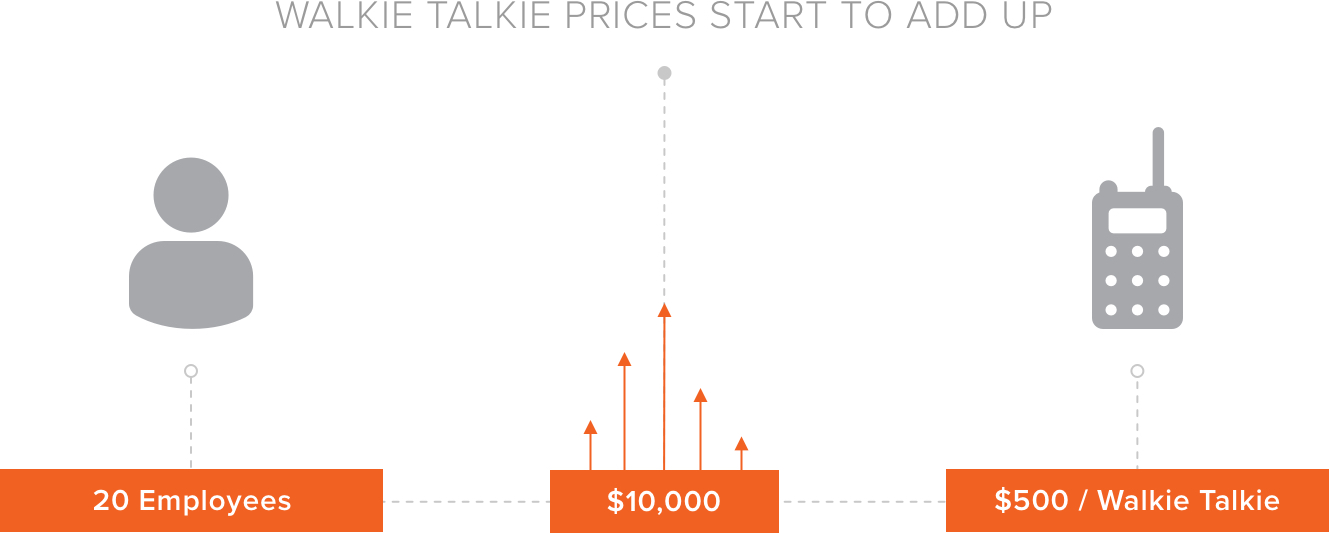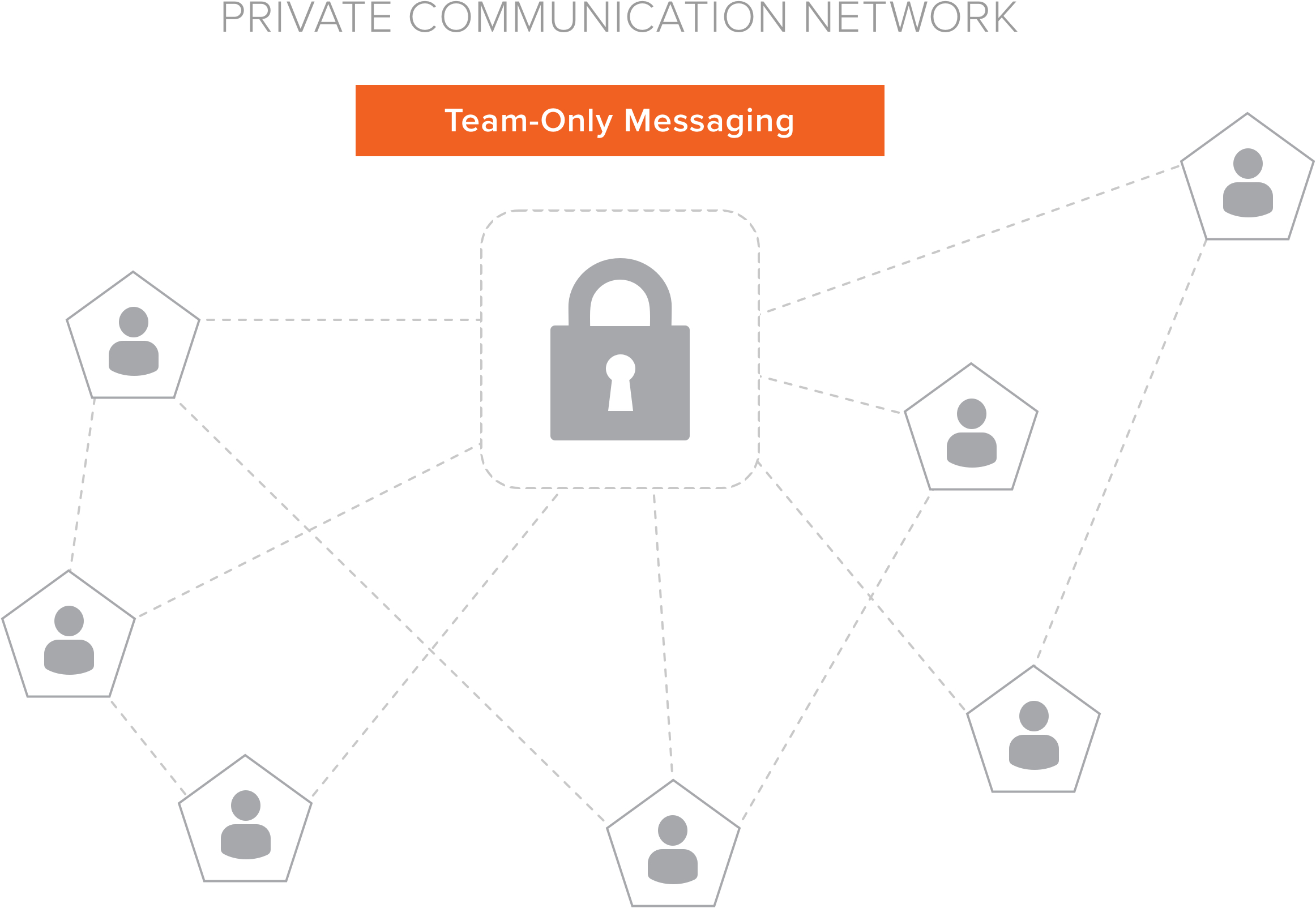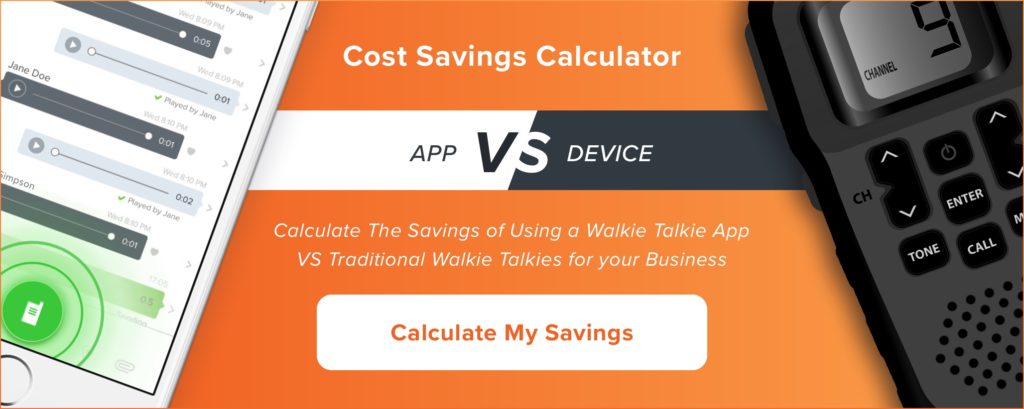How Much Are Walkie Talkies Costing Your Company?

Walkie talkies revolutionized business communication, transforming the frustrations of missed calls and text chains into seamless, smooth one-button communication. They’re also expensive.
But accessing a walkie talkie online, via a walkie talkie app, offers an affordable solution that’s more reliable than traditional walkie talkies. With Voxer’s walkie talkie app, you can contact your team wherever they are, with easy to use push-to-talk technology.
So how much do traditional walkie talkies really cost?
When most decision-makers think about costs, they primarily or exclusively contemplate the cost to purchase equipment. But traditional walkie talkies present hidden ‘costs’ as well:
- maintenance and upkeep
- lost time
- lost efficiency
Let’s take a look at what you really stand to lose if you have not already made the switch to digital walkie talkies.
How Much Do Traditional Walkie Talkies Cost?
GMRS (General Mobile Radio Service)
The more appropriate option for today’s businesses is to rely on two-way radios. Much like the CB radios that were so popular in the 1970s and 1980s, these radios can carry communications across much longer distances. These devices operate on a different frequency, called GMRS. GMRS is more reliable and communications can travel longer distances.
At the lowest end, you can find them for $100 or so apiece, but you may find these low-end options are rife with technical, security, and ease-of-use difficulties. Higher quality two-way radios tend to fall into the $400-$600 range. For large businesses that need only a few walkie talkies and rely heavily on communication, this might be a justifiable cost.
However, there’s a significant additional cost burden associated with two-way radios. You may only operate on a GMRS system with a license from the Federal Communications Commission. The licensing fee is usually several hundred dollars and must be renewed every 10 years.
Additionally, the number of licenses you need, the information you must provide, the exact cost of the licenses, and other details vary widely depending on how you intend to use the radio and similar factors. This can significantly increase startup and maintenance costs.
For most businesses, the costs of a quality handheld walkie talkie solution will end up being several hundred dollars per device. This may be on top of additional device costs, such as the cost of employee smartphones or tablets.
For example, a business with just 20 employees could easily spend $10,000 on walkie talkie startup costs alone, not taking into account the other significant costs involved!
Businesses that instead opt to switch to a walkie talkie app can completely avoid these costs. If they’re already paying for employees’ phones, tablets, or iPods, they’ll get more bang for their buck. And if employees bring their own devices, as is increasingly possible, it’s possible for a business to have no device costs at all.
The Ever-Looming Cloud of Compatibility Issues
A lot of businesses start out with traditional walkie talkies and then, as they grow, transition to two-way radios. This offers a vast improvement in quality and reliability of communication, but it comes at a steep price.
The commonsense strategy is to start with a GMRS system. But many businesses simply can’t afford the time, money, and effort this demands. It’s much better to start with a cost-efficient strategy that really works. Put the money into a savings account and use a reliable walkie talkie app instead.
Contemporary Walkie Talkie Alternatives: Costs and Considerations
A number of device manufacturers now offer another option that is more reliable and circumvents many of the licensing and other issues of GMRS radios. Several smartphone manufacturers offer push to talk (PTT) options across their mobile network.
The specifics of these devices vary from manufacturer to manufacturer. But generally, PTT is available on an existing smartphone, obviating the need for a massive upfront investment in new devices.
For many companies, this is a workable alternative to other solutions — at least at first glance. But contemporary PTT options through AT&T and other manufacturers present several cost issues:
- They will increase your service costs. The cost per month per device ranges from $5 to $30 or more. For large teams, this can add up to tens of thousands of dollars per year in additional costs. At $20 a month, a 500-member team would have $12,000 more per year additional walkie talkie costs.
- Compatibility issues can be a major stumbling block. If your team brings their own device to work, you may not be able to use PTT, or you might have to switch your team to devices on the same network. This can be just as costly, if not more so, as investing in two-way radios.
- Contemporary PTT options don’t have many features. You won’t typically be able to record calls, for example. This creates additional expense and time hassles. Why pay extra for fewer features?
- You will be locked into a plan that may commit you to a specific set of devices for years to come. If those devices don’t meet your other needs, you may have to buy additional devices. Even if the devices you’re forced to purchase are adequate, they may not be the best options for your team.
Hidden Costs: The Surprises No One Likes
In addition to start-up costs and monthly service fees, every device packs a powerful punch of hidden costs. The exact amount depends on the device you choose, the size of your team, and similar factors.
Some costs to anticipate include:
- Device maintenance. What does it cost to repair broken devices, to update devices, to manage security issues, and to ensure a particular device has all the accessories it needs to work well?
- Device replacement. No device lasts forever. How much will it cost you to replace devices over the years?
- The ever-looming cloud of security management. Whether you let employees bring their own devices or purchase devices for them, you’ll need to ensure they keep those devices secure. That can involve lots of cross-department cooperation, not to mention the involvement of an IT team to educate your staff and address security holes before they become serious issues.
Intangible Cost Considerations
The costs of various devices — as well as the costs of your overall communication strategy — include more than just the money you pay. Every business choice has intangible costs. Time is money. Every minute your team spends dealing with technical issues is time they could spend on building the business, attracting new clients, and offering excellent service.
When your team loses time, they lose money. Over time, lost time through frustration, technical glitches, and other issues can add up to a hefty bill. Consider the following intangible costs:
- Downtime. Two-way radios and PTT technology both inevitably come with downtime. Without incredible reliability, you may miss important communications. An app that doesn’t depend on traditional two-way radio frequencies, and which can record missed communications, prevents this.
- Lost information. If you use PTT or walkie talkie technology that cannot record conversations, you’re going to have to repeat information later, lose information, and waste time.
- Lost conversations. Depending upon the option you choose, you may end up with walkie talkies that cannot carry conversations across long distances. This renders your investment virtually worthless if you are unable to reach your team when you need to. This is especially important if you are dealing in logistics or delivery.
Voxer: An Affordable, Business-Savvy Alternative
Voxer takes push to talk technology to the next level. Our powerful, secure walkie talkie app eliminates many of the concerns of traditional two-way communication. You can communicate with your team anywhere, across a safe and secure network. You don’t have to invest in expensive equipment. Additionally, with our network privacy feature, businesses do not need to worry who employees are chatting with. With this enabled, employees can only talk to those within the business.
Your team only needs to install our app, which is compatible with both Android and iPhone operating systems. That means no more:
- Additional device costs
- Pricey network costs
- Need to invest in an FCC license
- Dropped conversations, difficulties communicating across long distances, or other frustrating wastes of time and money
Voxer also expands on traditional PTT technology and offers time and money-saving features that can help your team get more done with less time and less frustration, with:
- Both live and recorded audio options, so teams are no longer tied to certain time zones or appointment frames.
- Multimedia messaging.
- Voice-to-text transcription so you never again miss important information.
- Large group chats.
- Unlimited message storage for Pro members, so you don’t have to worry about lost information.
Voxer can be accessed on the web, and on all data networks. Let your team bring their own devices and install our app. Download the app to devices you already provide your team. You won’t have to worry about compatibility issues. And you’ll save money on these additional devices and service plans.
Voxer is affordable for businesses of all sizes, with a wide range of plans designed to suit every communication need. Get started by calculating your businesses savings of using Voxer vs traditional walkie talkies. The results will speak for themselves.



